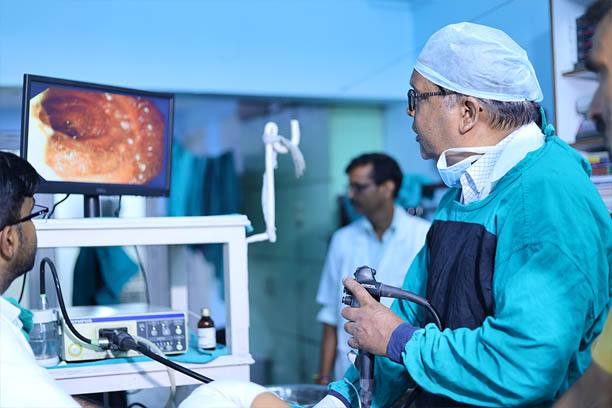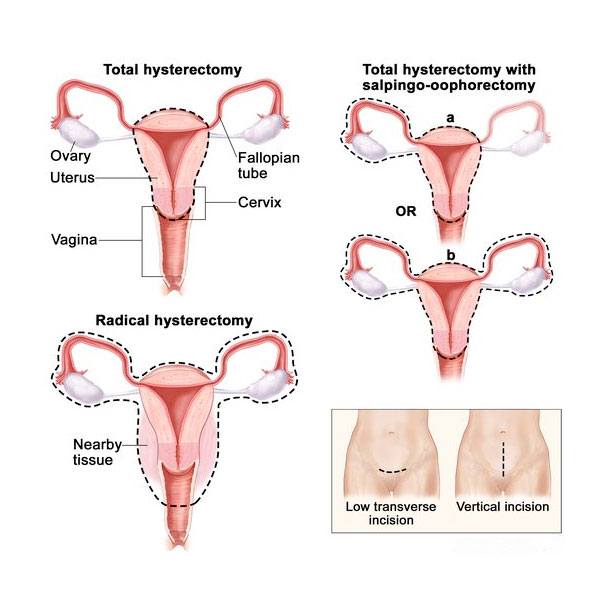Uterus Removal Surgery in Pilibhit
- Home
- Departments
- General & Lap. Surgery
- Uterus Removal (Hysterectomy)
Uterus Removal (Hysterectomy)
A hysterectomy is a surgical operation in which the uterus is removed.A hysterectomy is a surgical procedure that involves the removal of the uterus. This results in the loss of the ability to conceive and cessation of menstruation. Conditions such as abnormal bleeding, uterine prolapse, fibroids, and malignancy are common reasons for undergoing this procedure.

What is a hysterectomy?
In a hysterectomy, both the uterus and typically the cervix are surgically removed. Depending on the specific medical requirements, adjacent organs and tissues, such as the fallopian tubes and ovaries, may also be removed as part of the procedure. The uterus is where a developing fetus grows during pregnancy, and the lining you shed during your menstrual cycle is associated with it. Following a hysterectomy, the ability to conceive is lost, and menstruation ceases to occur.

What are the different kinds of hysterectomy?
● Total hysterectomy: The uterus and cervix are removed, but the ovaries are left in place.
● Supracervical hysterectomy: TThe upper section of the uterus is removed, but the cervix is left in place.
● Total hysterectomy with bilateral salpingo-oophorectomy: The uterus, cervix, fallopian tubes (salpingectomy), and ovaries are all removed during a total hysterectomy with bilateral salpingo-oophorectomy (oophorectomy). If you haven't gone through menopause yet, having your ovaries removed will trigger menopausal symptoms.
● Radical hysterectomy with bilateral salpingo-oophorectomy: The uterus, cervix, fallopian tubes, ovaries, the upper region of the vagina, and some surrounding tissue and lymph nodes are all removed during a radical hysterectomy with bilateral salpingo-oophorectomy. When malignancy is present, this type of hysterectomy is performed.
Why is a Uterus Removal (hysterectomy) performed?
Hysterectomies are performed for the treatment of:
- Hysterectomies are performed to treat abnormal or severe vaginal bleeding that cannot be managed with existing treatments.
- Menstrual discomfort that is unbearable despite previous treatment options
- Uterine fibroids or leiomyomas (noncancerous tumors).
- Increased pelvic discomfort caused by the uterus that is resistant to therapy.
- Uterine prolapse (when the uterus "drops" into the vaginal canal as a result of weakening support muscles) can cause urine incontinence or bowel problems.
- Cancer prevention for cervical or uterine cancer, as well as anomalies that may lead to cancer.
- Hyperplasia, recurrent uterine polyps, and adenomyosis are all conditions that affect the lining of your uterus.
Uterus Removal NDHV
A non-descent vaginal hysterectomy (NDVH) is a type of vaginal hysterectomy carried out when the uterus is not prolapsed. In this procedure, no visible scars are left since the uterus is extracted through the natural orifice, namely the vaginal opening, without the need for external incisions.
Advantages of NDVH surgery : NDVH is a frequent surgery in gynaecology that is nearly painless and smoother than a laparoscopy.
The following are some of the advantages of NDVH:
- There are no sutures or scars, therefore it is a scarless procedure.
- There aren't many complications.
- A short stay in the hospital and a quick recovery
- There is less pain following surgery.
- Other hysterectomies are more expensive.
Uterus Removal TAH - Total Abdominal Hysterectomy (TAH)
During the procedure, the uterus and cervix are removed. The decision to remove the fallopian tubes and ovaries depends on the individual case. If the ovaries are removed, the procedure is referred to as bilateral salpingo-oophorectomy (BSO). In a total abdominal hysterectomy (TAH), the entire uterus including the cervix is removed. For a total abdominal hysterectomy and bilateral salpingo-oophorectomy (TAH-BSO), both the uterus, cervix, and both fallopian tubes and ovaries are removed. TAH and BSO (TAH-BSO) remains the standard surgical approach for patients with endometrial cancer.
Uterus Removal TLH - Total Laparoscopic Hysterectomy (TLH)
This procedure employs a small surgical telescope known as a laparoscope to extract the uterus (womb) and cervix. The laparoscope is introduced through a minute incision in the abdominal wall, enabling the medical professional to visually examine the pelvis and abdomen. This gynecological surgical intervention entails the removal of the uterus and cervix through the vaginal canal using a minimally invasive (laparoscopic) technique. If the purpose of the surgery is to address cancer, the removal of your ovaries, fallopian tubes, and pelvic lymph nodes might also be necessary. Depending on your age, the removal of ovaries might induce menopause.
General & Lap. Surgery
Headed by Dr. P. D. Singh, one of the finest surgeon in the region for General & Laparoscopic Surgeries with best in class and advance equipment.
Urological Surgeries
Dr. Rohit Singh at P.D.S. Hospital performs highly advanced urological procedures in the Kamayun and Rohilkhand region.
Training Programs
Our aim is to educate the new and practicing doctors, in various specialties, like laproscopic surgeries and urology related surgeries.
